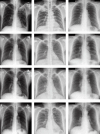Adapted generative latent diffusion models for accurate pathological analysis in chest X-ray images
- PMID: 38499946
- PMCID: PMC11190015
- DOI: 10.1007/s11517-024-03056-5
Adapted generative latent diffusion models for accurate pathological analysis in chest X-ray images
Abstract
Respiratory diseases have a significant global impact, and assessing these conditions is crucial for improving patient outcomes. Chest X-ray is widely used for diagnosis, but expert evaluation can be challenging. Automatic computer-aided diagnosis methods can provide support for clinicians in these tasks. Deep learning has emerged as a set of algorithms with exceptional potential in such tasks. However, these algorithms require a vast amount of data, often scarce in medical imaging domains. In this work, a new data augmentation methodology based on adapted generative latent diffusion models is proposed to improve the performance of an automatic pathological screening in two high-impact scenarios: tuberculosis and lung nodules. The methodology is evaluated using three publicly available datasets, representative of real-world settings. An ablation study obtained the highest-performing image generation model configuration regarding the number of training steps. The results demonstrate that the novel set of generated images can improve the performance of the screening of these two highly relevant pathologies, obtaining an accuracy of 97.09%, 92.14% in each dataset of tuberculosis screening, respectively, and 82.19% in lung nodules. The proposal notably improves on previous image generation methods for data augmentation, highlighting the importance of the contribution in these critical public health challenges.
Keywords: Chest X-ray; Deep learning; Lung nodules; Stable diffusion; Tuberculosis.
© 2024. The Author(s).
Conflict of interest statement
The authors declare no ocmpeting interests.
Figures











References
-
- Gibson GJ, Loddenkemper R, Lundbäck B, Sibille Y (2013) Respiratory health and disease in Europe: the new european lung white book. Eur Respir J 42(3):559–563. 10.1183/09031936.00105513 - PubMed
-
- Eccles R (2009) In: Eccles, R, Weber, O (eds.) Mechanisms of symptoms of common cold and flu, pp 23–45. Birkhäuser Basel. 10.1007/978-3-7643-9912-2_2
MeSH terms
Grants and funding
LinkOut - more resources
Full Text Sources

